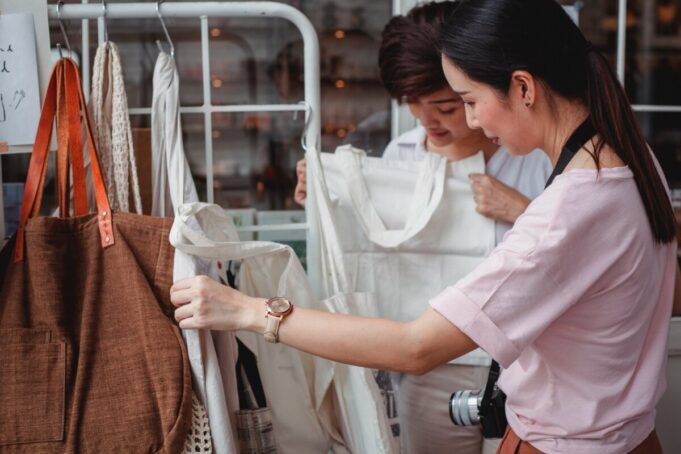Sustainable fashion and circular fashion have been gaining momentum in recent years as more consumers become aware of the detrimental impacts of fast fashion on the environment. The traditional linear model of take-make-dispose is being challenged by innovative brands adopting circular economy principles of reduce, reuse, recycle and regenerate. This article explores the meaning of circular fashion, the urgent need for it, its core principles and real-world examples, the benefits it brings, as well as the challenges and opportunities that lie ahead. Embracing circularity is key to transforming the fashion industry into a regenerative and ethical system.
What is Circular Fashion?
Circular fashion refers to clothes, shoes and accessories that are designed, sourced, produced and provided with the principles of a circular economy in mind. The goal is to keep materials in use and retain their value for as long as possible. This contrasts sharply with the traditional linear model of make-use-dispose that has led to immense waste and pollution. Circular fashion aims to decouple economic growth from resource extraction through innovative business models and careful design.
Key principles that underpin circular fashion include design for longevity, use of sustainable materials, recycling and upcycling, renting and sharing, and ultimately avoiding waste and pollution. It is about slowing, closing and narrowing material and resource loops in the fashion industry. Circular fashion provides a holistic and systemic approach to address the fashion industry’s sustainability crisis.
The Need for Circular Fashion
The fast fashion industry operates on a linear business model which extracts large amounts of natural resources, generates immense waste and pollution, and exploits low-wage labor. More than 150 billion garments are produced annually, most ending up in landfills and incinerators after a short period of use. Fashion accounts for 4% of global greenhouse gas emissions, more than international flights and maritime shipping combined. Microplastics from synthetic textiles are polluting waterways and oceans. Cotton farming uses copious amounts of water and chemicals. With the fashion industry poised to grow even bigger, it is imperative that we transition towards a circular model.
Circular fashion principles provide a much needed solution to curb overproduction, improve resource efficiency, utilize renewable energy, eliminate hazardous chemicals, and empower local communities. A systemic overhaul is required to radically rethink fashion cycles, make effective use of materials, and ensure clothes are worn for longer and recycled properly. Circular fashion provides a framework for the industry’s regeneration.
Principles of Circular Fashion
Several principles form the core of circular fashion and differentiate it from the dominant linear model:
Design for Longevity and Durability
Clothes are designed for longevity, made from durable materials and construction methods that extend their useful life. Features such as timeless design, modularity, multi-functionality and easy repair should be incorporated.
Sustainable Materials and Processing
Materials used are non-toxic, renewable, organic, recycled or upcycled. Clean production processes with renewable energy, resource efficiency and fair labor conditions are employed.
Repair, Reuse, Remanufacture
Brands encourage repairing, reusing, reselling, swapping, and upcycling of garments to retain their value. Take-back programs give used clothes a second life.
Recycling and Circularity
All products and materials are designed to be recycled. Brands implement closed-loop recycling wherever possible. Waste and pollution are avoided.
Rental and Sharing Models
Clothing rental, resale, subscriptions, and peer-to-peer sharing models promote access over ownership and keep clothes in use longer.
Traceability and Transparency
Blockchain, RFID tags, and other technologies allow tracing a garment’s origins, materials, carbon footprint, and next use phase. Transparency builds trust.
Examples of Circular Fashion Initiatives
Innovative brands and organizations around the world are pioneering circular practices and creative solutions to build a regenerative fashion industry:
- Rental Services: Companies like Rent the Runway, Nuw, Rotaro and HURR are providing consumers temporary access to designer clothing rather than ownership.
- Resale Platforms: Depop, ThredUp, Poshmark and TheRealReal have made second-hand clothing popular. Patagonia’s WornWear encourages resale of its products.
- Upcycling: Brands like Christopher Raeburn and Asai upcycle discarded materials into new garments. Atelier L.E.S.S repurposes leftover luxury fabrics.
- Sustainable Materials: Pinatex made from pineapple leaves, grape leather, recycled nylon and ECONYL, organic cotton, linen, hemp and TENCEL provide eco-friendly alternatives.
- Closed-Loop Recycling: Zara’s Join Life collection, Levi’s, Evrnu, and Infinited Fiber recycle used garments into new ones. Adidas and Parley make shoes from ocean plastic.
- Transparency: Fashion Revolution’s Fashion Transparency Index, VeChain, Provenance, and blockchain track supply chains. Higg Index by Sustainable Apparel Coalition measures sustainability.
The Benefits of Circular Fashion
Transitioning to a circular fashion model presents a multitude of benefits for the environment, society, economy, and consumers:
- Reduced Environmental Harm: Circular fashion dramatically lowers greenhouse gas emissions, water use and pollution, microfiber release, and waste compared to fast fashion. It conserves forests, land, and biodiversity.
- Enhanced Resource Efficiency: Materials are utilized optimally and kept in circulation through reuse, repair and recycling. Renewable energy and eco-friendly processes are used.
- More Sustainable Industry: Circular practices ensure fashion has a positive social impact through fair wages, improved worker conditions, and supply chain transparency.
- Economic Opportunities: Circular fashion spurs innovation, creates skilled green jobs, opens new markets, and provides cost savings in the long run.
- Empowered Consumers: People gain access to sustainable fashion options and can make conscious choices to support circular brands.
- Future-Fit for Evolving Landscape: Circularity equips the fashion industry to adapt to climate change, resource scarcity, population growth, and technological disruption ahead.
Challenges and Opportunities for Circular Fashion
Despite its many advantages, there are challenges to adopting circular fashion universally:
- Consumer Behavior: Fast fashion addiction, lack of awareness, and reluctance to change entrenched habits are obstacles. Circular fashion needs more vocal supporters.
- Infrastructure Deficit: Collection, sorting, recycling and redistribution systems are underdeveloped in many regions. Policy and investments must expand infrastructure.
- Industry Collaboration: Fashion value chain is complex with fragmented stakeholders. More open collaboration between brands, suppliers, policymakers and innovators is vital.
- Technological Innovation: Advances in materials science, traceability, microfibre capture, reuse and biodegradability solutions need scaling up.
- Policy Interventions: Governments have a crucial role in providing incentives and an enabling environment through regulation and public procurement.
However, growing consumer awareness, technology innovations, startups disrupting the status quo, and sustainability commitments from industry leaders all point to increasing opportunities for circular fashion. We are at a pivotal moment to fundamentally transform the industry.
The Future of Circular Fashion
The fashion industry is gradually waking up to its unsustainable and unethical practices. A circular approach presents the most comprehensive and forward-looking solution to establish fashion as a force for good. While the transition will take time, the future is promising:
- Sustainable materials will become mainstream, making circular design the norm rather than the exception.
- Clothing will be valued like durable assets and kept in use through repair, resale, rental, and recycling.
- Stranded assets and waste will be eliminated through effective recovery, take-back and closed loop recycling.
- Supply chains will be completely transparent and adopt regenerative practices.
- Consumers will embrace circular fashion as it becomes more accessible and aspirational through innovative brands.
- Technology will enable circularity through material innovations, product passports, blockchain-enabled traceability, virtual fitting, customization, re-commerce, etc.
- Policy, infrastructure, finance and skills will be aligned to accelerate the transition.
The circular fashion movement is gathering momentum globally. Consumers, brands, innovators, and regulators must come together to fundamentally reimagine fashion as regenerative – creating prosperity, enhancing lives, and restoring nature’s balance. The future of fashion is circular.
Conclusion
The linear take-make-waste model of fast fashion is proving environmentally, socially and economically unsustainable. Circular fashion principles provide a much needed framework and holistic solution to address these challenges. As consumers become more aware of sustainability issues, innovative brands adopt circular practices, infrastructure and policies evolve, technology progresses, and industry stakeholders collaborate, the fashion industry can be transformed into an ethical system. The rise of circular fashion will allow us to meet our needs while protecting the planet and empowering communities. We all have a role to play in accelerating this transition for current and future generations.




































